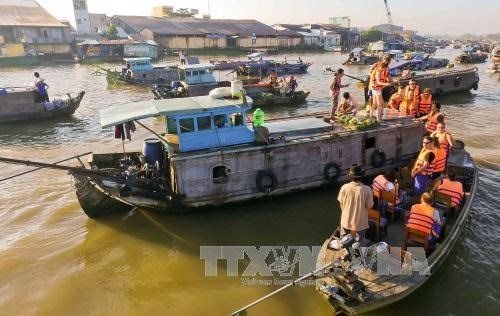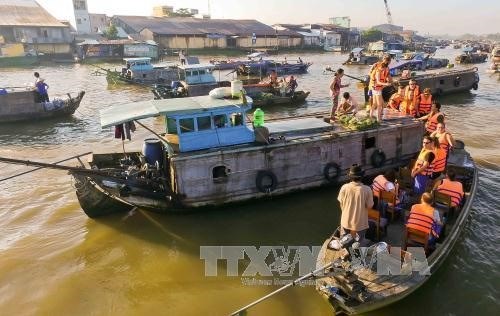
The Mekong Delta city of Can Tho enjoyed strong growth in tourism last year due to a series of international political and cultural events and traditional festivals, according to the municipal Department of Culture, Sports and Tourism.

Visitors
at Cai Rang Floating Market in Can Tho city (Source: VNA)
The number of tourist arrivals surged 40 percent to 7.5 million, while tourism
revenues rose 61 percent to 2.9 trillion VND (127.6 million USD).
The political, cultural and tourism events the city hosted included the APEC
Food Security Week, Vietnam-Japan Culture and Trade Exchange, and the Southern
Traditional Cake Festival.
The tourism sector is focusing on developing river-based tourism, especially
upscale products such as three- to five-star cruise ships, Le Minh Son, deputy
director of the department, said.
It is encouraging investors to develop inter-provincial and international
river-based tours, he said.
The tours are designed to take in historical and cultural relics, traditional
craft villages, and ecological and spiritual destinations.
Last year the neighbouring province of An Giang attracted 7.3 million visitors,
up 12 percent, earning revenues of 3.7 trillion VND (162.8 million USD).
The province is the centre of spiritual tourism in the south, with people
flocking especially to Ba Chua Xu Temple in Chau Doc town.
Kiên Giang province, with its beautiful landscapes, islands such as Phu Quoc,
archipelagoes such as Nam Du and Ba Lua and the U Minh Thuong National Park,
attracted more than six million visitors last year.
The province’s tourism revenues were worth more than 4.58 trillion VND (201.52
million USD), the highest in the delta.
Source: VNA
Spanning thousands of hectares and winding gracefully along mountain slopes, hillsides, and riverbanks, the terraced rice fields of Lac Son District present a stunning and captivating beauty. This region, renowned for its remarkable terraced landscapes, is also the centre of Hoa Binh Culture known for numerous archaeological sites.
The life of Mong people in Hang Kia and Pa Co communes of Mai Chau district has improved much thanks to tourism development.
The man-made Hoa Binh Lake, with a water surface area of approximately 9,000 hectares and a capacity of 9.45 billion cubic meters, stretches over 200 kilometers from Hoa Binh to Son La provinces. With the goal of developing into a national tourism area, the Hoa Binh Lake tourism area is expected to not only become the largest tourism centre in the province but also one of the 12 key tourist destinations in the northern midland and mountainous region of Vietnam.
Da Bia hamlet, now Duc Phong, in Tien Phong commune, Da Bac district, was once almost isolated from the outside as the only way to the hamlet was to get a boat ride across the Hoa Binh reservoir. However, as its tourism potential has been unleashed, the hamlet has established itself as one of the most attractive destinations on the tourism map. It has even received the ASEAN Community-Based Tourism Awards in 2019.
In the first 9 months of 2024, Mai Chau district, Hoa Binh province welcomed over 684 thousand visitors to visit and relax. In which, over 516 thousand domestic visitors and more than 168 thousand international visitors. Total revenue from tourism is estimated at over 821 billion VND.
Da Bac district, bestowed with stunning landscapes, is developing ecological and resort tourism offerings. Several tourist sites, put into operation this year, has attracted throngs of high-spending and young domestic visitors.



